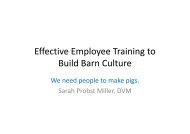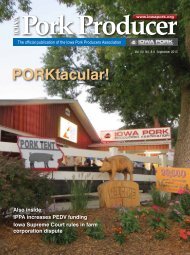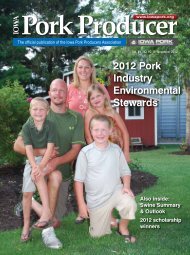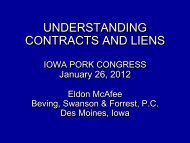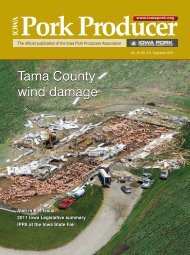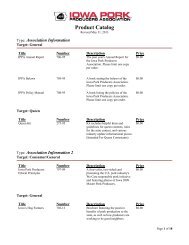Pork Congress 2012 - Iowa Pork Producers Association
Pork Congress 2012 - Iowa Pork Producers Association
Pork Congress 2012 - Iowa Pork Producers Association
You also want an ePaper? Increase the reach of your titles
YUMPU automatically turns print PDFs into web optimized ePapers that Google loves.
Specifically, the research trials showed that groups of<br />
pigs headed to market can experience lower mortality<br />
rates in warm weather and overall improved well-being<br />
year-round when less bedding is used in transport<br />
trailers. According to McGlone, the current standard in<br />
the industry is to use four bales of bedding per semitrailer.<br />
“During the study we found that the surface temperature<br />
of the pigs changed with the air temperature and that<br />
increased surface temperature actually caused a negative<br />
effect on the pigs’ welfare,” McGlone said. “In cold<br />
weather, we found that there is no added effect to using<br />
more than six bales of bedding per trailer.”<br />
“We concluded that if the industry changed to using<br />
only three bales per trailer, it would create a big savings<br />
with no change in welfare,” McGlone said. “So it’s<br />
something the industry will need to consider carefully.”<br />
The National <strong>Pork</strong> Board has responsibility<br />
for Checkoff-funded research, promotion<br />
and consumer information projects and for<br />
communicating with pork producers and<br />
the public. Through a legislative national<br />
<strong>Pork</strong> Checkoff, pork producers invest $0.40<br />
for each $100 value of hogs sold. The <strong>Pork</strong><br />
Checkoff funds national and state programs<br />
in advertising, consumer information, retail<br />
and foodservice marketing, export market<br />
promotion, production improvement,<br />
technology, swine health, pork safety<br />
and environmental management. For<br />
information on Checkoff-funded programs,<br />
pork producers can call the <strong>Pork</strong> Checkoff<br />
Service Center at (800) 456-7675 or check<br />
the Internet at www.pork.org.<br />
Task force outlines “road map” to<br />
Improve sow lifetime productivity<br />
How productive sows are during their lifetimes has<br />
sizeable economic and animal welfare implications for<br />
the U.S. pork industry. That’s why the <strong>Pork</strong> Checkoff<br />
created the Sow Lifetime Productivity Task Force to<br />
chart a “road map” of research tactics to improve sow<br />
retention rates and pig survival.<br />
The task force, made up of leading industry experts,<br />
has set a goal of improving sow lifetime productivity<br />
by 30 percent over the next seven years, according to<br />
Chris Hostetler, director of animal science for the <strong>Pork</strong><br />
Checkoff.<br />
The task force recommends research priorities be<br />
concentrated on three main areas:<br />
1. Increasing sow life in the herd through focused<br />
research on increasing average number of parities per<br />
sow and decreasing herd fall-out in the early parities.<br />
2. Increasing the number of pigs weaned per litter<br />
through improved litter size at birth and decreased<br />
pre-wean mortality.<br />
3. Optimizing gilt development and retention to<br />
increase lifetime productivity.<br />
March <strong>2012</strong><br />
59




